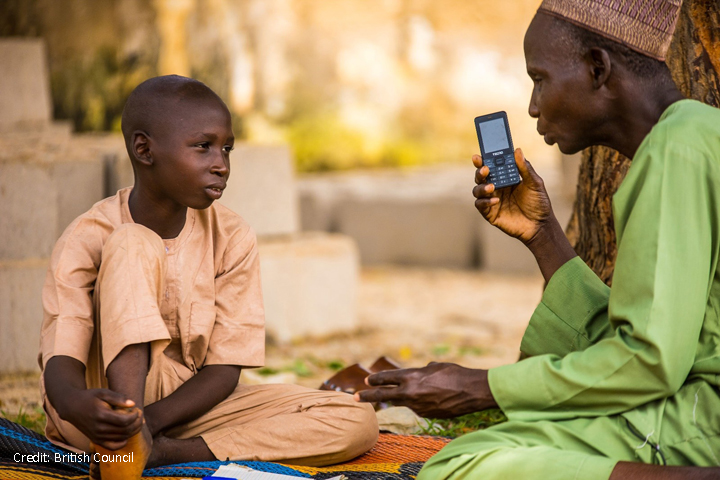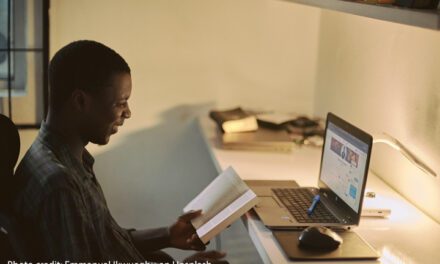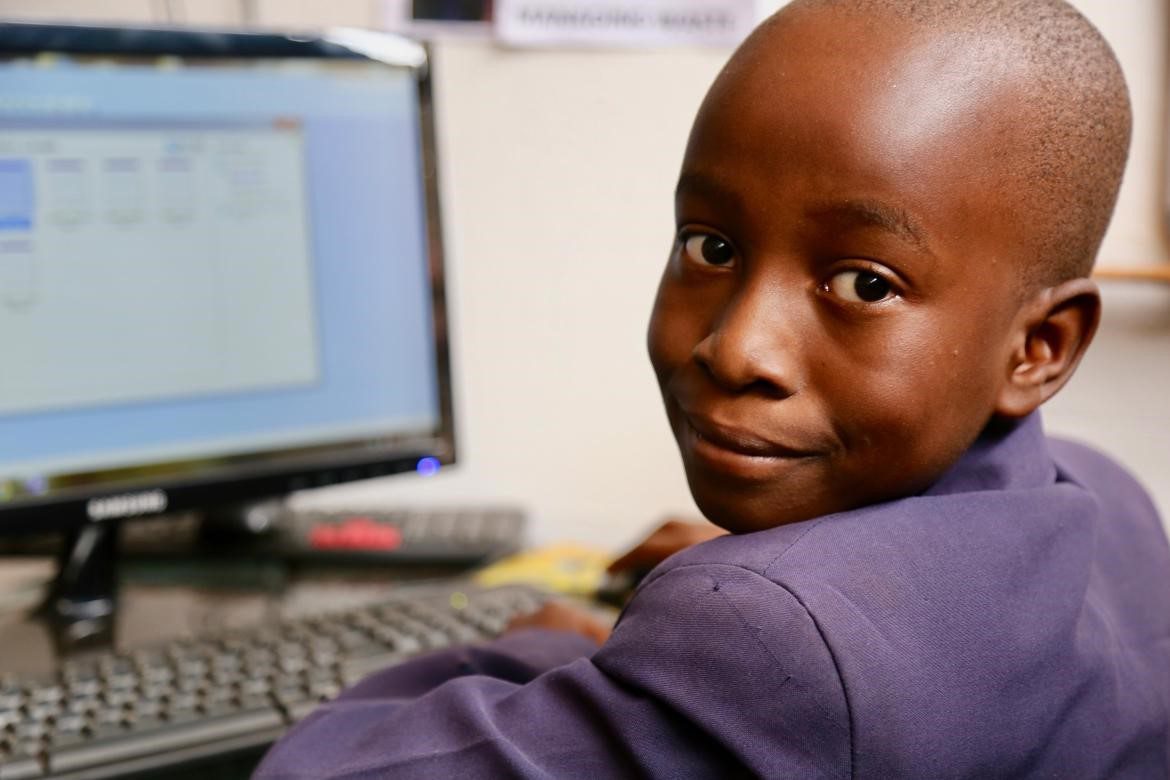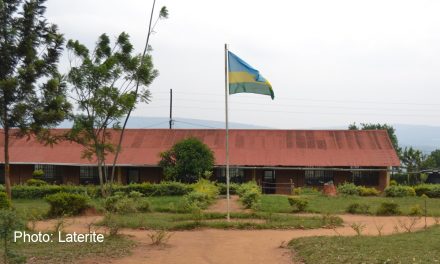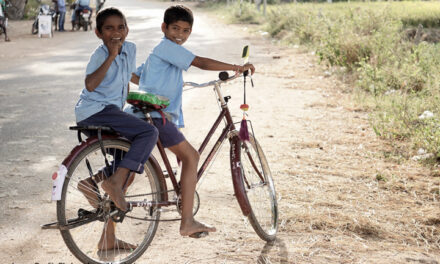This article was written by Caroline Grant, senior education adviser for Sub-Saharan Africa, British Council, and Ashleigh Morrell, Teaching at the Right Level (TaRL) Africa leadership team.
The Kano State Universal Basic Education Board (SUBEB), the British Council, Teaching at the Right Level (TaRL) Africa and the Foreign Commonwealth and Development Office (FCDO) launched the Kano Literacy and Maths Accelerator (KaLMA) in October 2019 in two local government authorities, Wudil and Dawakin Tofa. The programme, currently reaching over 37,000 children, is rooted in the TaRL approach. KaLMA pilots two innovations: a dual language approach to learning English, using mother tongue to support learning an additional language, and student teacher facilitation.
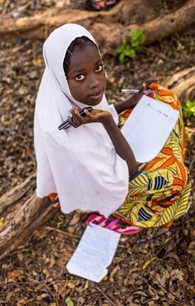
Fatima Idris, a P6 pupil from Dawakin Tofa, listening to a KaLMA radio broadcast on her father’s phone
Baseline results in January 2020 confirmed the need for foundational skills-focused programmes in upper primary (P4-P6). Only seven percent of children could read a basic paragraph in their home language, Hausa; three per cent were able to respond ‘yes’ or ‘no’ to simple written questions in English, and just four per cent were able to solve a simple subtraction problem. A rapid assessment of 6,835 children in March 2020 to assess whether learning gains had been made during the initial KaLMA implementation period found that, for this set of children, the number who were able to read a simple Hausa paragraph had increased by 16 percentage points (pp) between January and March 2020; those who could answer a simple subtraction sum increased by 23 pp; while those who could answer ‘yes’ or ‘no’ to simple written questions in English increased by 30 pp. The results were similar for girls and boys across all three subjects.
Between May and November 2020, during the first wave of the COVID-19 pandemic, the programme flexed to continue to provide learning support to children and families at home by sharing learning activities through low-tech delivery mechanisms such as radio, text message, automated voice message (AVM) and interactive voice response (IVR)[i]. These home-based learning interventions were informed by research available on low-tech education interventions and experience of others working on similar interventions, such as Pratham and the Building Learning Foundations remote learning programme in Rwanda.
KEY FINDINGS from the home-based learning intervention
- Caregiver engagement in children’s learning increased over time. This suggests that the programme content and delivery could have improved over time and that caregivers developed an appreciation for content over time and thus increased their engagement.
- Caregiver engagement varied by literacy level and subject. Engagement was not uniform across subject or caregiver literacy level. On average, caregivers with limited literacy engaged in their children’s learning less, and fewer caregivers engaged in their children’s English learning, which is likely to be linked to their competency in English.
- Different support modalities were used differently. Text messages were the most popular content delivery modality among caregivers surveyed, while radio and AVMs (which had the advantage of being understood by non-literate caregivers) were used less by respondents in the sample. Reports from caregivers indicate that the preference for text messages is driven by convenience. Text messages can be used to support learning irrespective of the time of the day, and the ability to store past home-based learning (HBL) text messages serves as an archive for the respondents which they can refer to at any time. However, the sample was made up largely of households who had access to a Hausa literate family member. Radio had the advantage of reaching large numbers of households – up to 4.6 million in Kano State. More research is required to understand how these learning support modalities would fare for households that do not have a literate Hausa family member.
POLICY LESSONS
- Primary caregivers face several barriers in effectively accessing learning support for their children.
- How remote, technology-based support is crafted to match the level of literacy and technology access of the household could to some extent help address the barrier of caregivers’ access to learning support for their children.
- Technology ownership in the household revealed that if only one family member has access to a phone or a radio it usually remains in their possession, and this device needs to be transferred (usually from the head of household) to the primary caregiver for it to be effective. Low-tech remote solutions that can be stored on a device, and accessed or shared later, such as text messages or SD cards with content, could help address this issue.
- There is need for audio content to help children develop basic listening and speaking abilities, since oracy is a platform for literacy in both the mother tongue (Hausa) and an additional language (English). As delivery modalities for audio-based learning, radio and SD cards with audio files are particularly well suited to content designed to support the growth of oracy.
- For inclusion and equality of opportunity, content needs to be offered in a variety of formats e.g. text-based, pictorial or audio that reflect distinct personal preferences. Providing an audio learning resource, for example, helps address the needs of children whose preferred learning style is via the spoken word. This aligns with both oral cultures, such as in northern Nigeria, where speech is the primary mode of communication, and classroom settings where teaching and learning is predominantly through talk.
- Sensitisation efforts in times of change are critical for take-up. To increase household awareness of HBL, a series of awareness raising efforts boosted not only awareness but also engagement.
- Feedback mechanisms are essential for catching technology snags, and adapting content is key for continued improvement
CONCLUSION
School closures have contributed to the increased need for accelerated learning foundational skills programmes. While much has been learned about how to deliver home-based content and communications to support children’s learning in the context of Kano State, this is not a substitute for schooling in communities with limited access to technology and low levels of household literacy. However, there are elements of the HBL programme which could usefully augment the in-school programme while at the same time providing a buffer against future pandemics.
[i] The IVR platform housed the HBL toll-free line, additional learning content, survey questions for the teacher competency element and daily AVMs for parents to access if the initial direct call was delivered at an inconvenient time.

